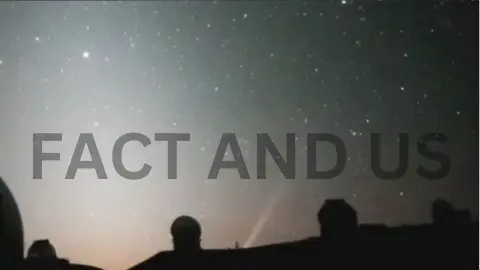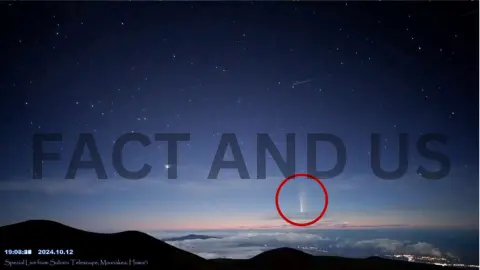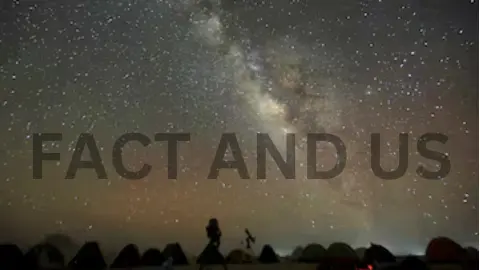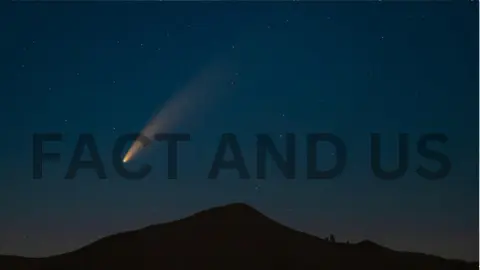An extraordinary and special live stream was launched from the Subaru Telescope, operated by the National Astronomical Observatory of Japan. This Mauna Kea Observatory in Hawaii has captured in timelapse video on 12 October a comet pass by Earth.
Scientists estimate that the comet can be seen from Earth only once in 80,000 years. The comet will be visible throughout the end of October.

It streaked across the Hawaiian skies-a breathtaking celestial event that captivated both the stargazers and astronomers. The cosmic sight was captured in stunning detail through a timelapse video, in what proves to be a once-in-a-lifetime view of the comet during its journey across night skies. The rare spectacle has already sent excitement among all Earthlings, and in this case, the people of Hawaii is sure to get a perfect view because of their unique position.
A comet called Comet C/2024 P1 passed closest to Earth this week, and the University of Hawaii Institute for Astronomy release indicates that it is only sky watchers on the islands who get the privilege to view its brightness because of pristine clear skies in the islands with minimal light pollution. A timelapse captured by astronomers at the Mauna Kea Observatory captures the glowing comet shining with its shimmering tail cutting through star-filled heavens, giving it an eye-catching look compared to what this rare astronomical visitor offers.
Contents
A Stellar Jewel
The brightest comet that has passed over Earth in recent times is comet C/2024 P1. The comet is among the most brilliant ones found this year when a group of astronomers from Chile discovered it. Indeed, comets traverse the solar system periodically, but only a few of them are bright enough to be discerned by naked eyes.


It was composed of ice, dust, and rocky particles, so when it drew near the sun, it began to warm up, and its tail, in effect a stream of gas and dust, became more vivid and visible. This is what made possible the spectacular show those people were treated to. In Hawaii, under optimal conditions of atmosphere for astronomical observation, really, it was a sight.
“It is decades since we’ve seen a comet that’s this bright,” said Dr. Emily Wong, astronomer at the Mauna Kea Observatory. “It’s just beautiful to be able to catch it in a timelapse because it really shows how dynamic the night sky can be.”
Perfect Viewing Conditions in Hawaii
Hawaii was one of the best locations on Earth to observe a comet because it is located in a relatively dark area of the world, with minimum light pollution and observatories at higher altitudes. The summit of Mauna Kea is more than 13,000 feet above sea level and boasts some of the world’s clearest skies for unimpeded sky gazing.
In the timelapse video, tail extends from the sky carrying the comet, shining bright amidst twinkling stars and distant galaxies. The visual treat is therefore assured to the viewers as the comet is seen cruising beautifully through the sky and its brilliant tail grows intense as it draws nearer to Earth.

The timelapse soon went viral, with thousands of people sharing the breathtaking footage of Comet PanSTARRS on social media. Many viewers marveled at how beautiful the icy blue-green color was, lit up by its tail like a cosmical brush stroke across the night sky.
A Global Event
While the best views of Comet C/2024 P1 have been offered by Hawaii, opportunities have occurred for individuals all over much of the world to see the comet, albeit without the same amount of distinctness. Those living in parts of North and South America and Asia have been reportedly seeing the comet while amateur astronomers have pointed their telescopes at the sky from backyards to observatories hosting viewing events.

Many astronomers are wishing that the public would take this opportunity to view the comet before it disappears from view again. Comet C/2024 P1 will still be visible for another week, at which point it will disappear from view since it is moving out of the inner solar system and it is not expected to come back into view for thousands of years.
“This is a rare event,” Dr. Wong noted. “We may never see this particular comet again in our lifetime, so we’re urging everyone, whether you’re in Hawaii or not, to look up and take a moment to appreciate this incredible natural wonder.”
Timelapse Inspires New Stargazers
For many, this timelapse video reignited a passion for astronomy and the mysteries of the universe. Local observatories and centers have reported an uptick in visitors and inquiries related to upcoming stargazing events, while there is also much ado online, as amateur astronomers share tips on the best ways to view the comet with the naked eye or through a telescope.
“Moments like these remind us how small we are in the greater cosmic scheme,” said Kiana Hanalei, a local Maui stargazing buff. “What really went through my head while watching the timelapse was this sense of connection with something much larger, incredible to think about that probably ancient civilizations saw something like it and had the same wonder.”

Astronomers are keenly observing the trajectory of a comet as it moves through the solar system. As a rare opportunity presents itself, astronomers can make a variety of analyses about the composition of this comet and its behavior. This would significantly help in understanding how our solar system was formed, and what comets really are.
For now, the world stands in awe as Comet C/2024 P1 lights up the sky at night, giving people a peek at what lies out there in the universe — a reminder that, rarely, the stars are aligned to show and g
stay connected with fact and us for more such news.
